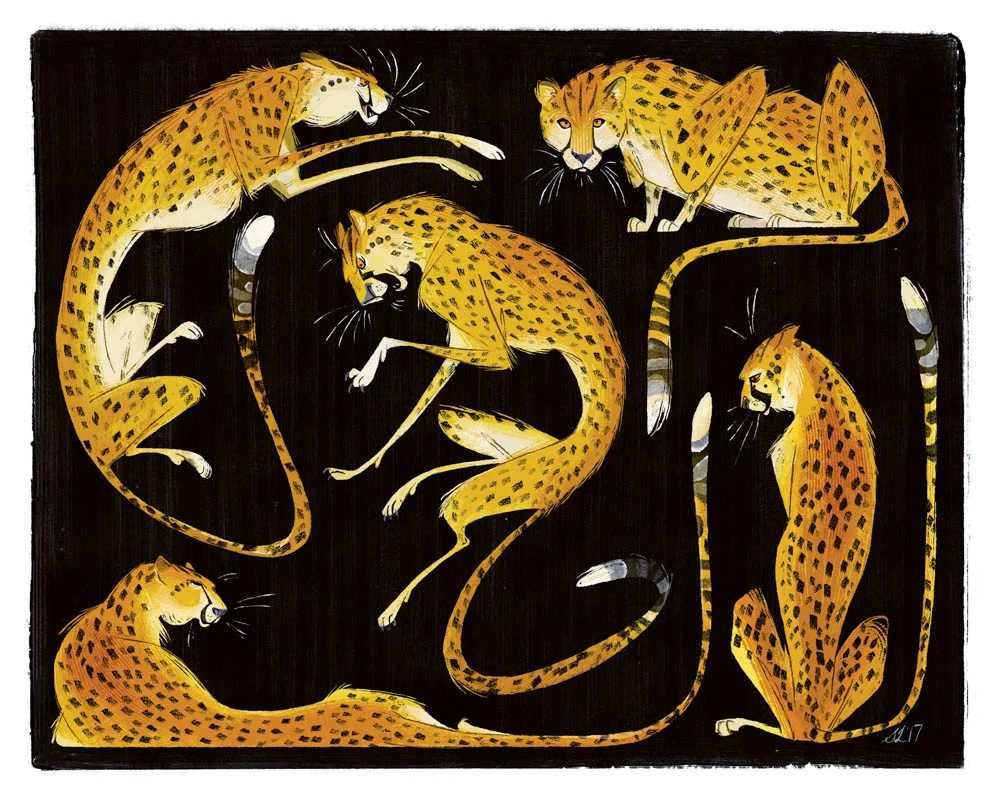Cheetah
"Liquid Feline" by Steph Laberis (digital)
“I chose the cheetah because I wanted to have fun with some elongated cat poses! I love painting textures, so each animal provided a different challenge in terms of capturing spots, stripes and scales.”
Your purchase is helping Expedition Art and Saving Species purchase land in Sumatra! Learn more about the project.
Habitat
Historically, cheetahs were found across large swaths of Africa and Asia, with populations extending from South Africa to India, in savannas and grasslands. They prefer dry, open grasslands where they can pick up speed to chase and kill their prey. Some populations of individuals have reportedly been found in southern Algeria, northern Niger and Iran, far beyond the majority of the small remaining population.
Family Life
Cheetahs are typically solitary animals. While males sometimes live with one or two of their brothers, females are generally found alone, unless they have offspring. They will raise these cubs alone, but because of high incidences of infant mortality due to predation, they will stay hidden for the first couple months of their lives. Infants remain with their mother for around a year and a half before venturing on their own. Cheetahs communicate primarily through vocalizations such as purrs, bleats, barks, growls, hisses and even a high pitched chirping sound.
Lifespan
Cheetahs have been recorded to live up to 20 years in captivity but their life expectancy in the wild is considerably less, usually only six to eight years.
Hunting Habits/Diet
Cheetahs are carnivores who eat a variety of midsize prey including gazelles, wildebeest calves, impalas and smaller hoofed animals. Cheetahs chase and kill their prey by biting their necks after knocking them to the ground. Other big cats and predators in their habitat often steal their kills so cheetahs eat quickly to avoid this. They camouflage themselves in the tall grasses and hunt in the late morning or early evening as opposed to the night.
Population
Around 6,700 cheetahs remain in the wild.
Fun Fact
The cheetah is the fastest of all land animals in the world; it is able to reach speeds of up to 68-75 mph and takes just two strides for to reach 45 mph. This big cat has adapted in very distinct ways to support its speed including claws that do not retract in order to grip the ground better, large nostrils to increase air flow and a particularly long tail to help it balance around corners. The name “cheetah” is based on the Hindi Chita word meaning “spotted one”.
Why are they endangered?
Humans and human activity are the primary reasons that the cheetah population is vulnerable. Habitat fragmentation presents a significant problem. Cheetahs are also subject to vehicle collisions and poaching. They are in competition with the human population for their prey and heavy hunting diminishes their potential for successful kills. Other threats include high demand for cheetah cubs as pets, mainly in the Middle East. Additionally, cheetahs can be perceived as a threat to livestock, even though they rarely take domesticated animals.
Status
Vulnerable



